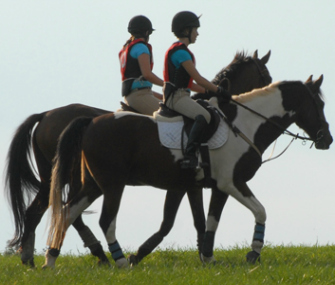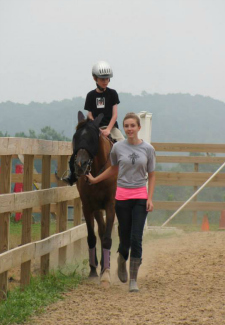Is Your Child Ready for Horseback Riding Lessons?
Published on July 11, 2014
Skip To

So when their kids start requesting riding lessons, many parents find themselves wondering: Is my child ready?
Here are some guidelines to help you determine if your little one is ready to get in the saddle or would be better off waiting to pick up the reins.
Professional Input
Talk with an instructor who has a good reputation and experience working with children. Because every child’s developmental timeline is different, an expert can help you determine your child’s readiness. And safety should always be at the forefront of the discussion, says Dana Surrusco, owner of HorseSense Riding Academy in Ellijay, Georgia.Observing other children riding is also helpful, says Shelley Mann, spokesperson for The United States Pony Clubs (Pony Club), a nonprofit national youth organization that teaches riding and horsemanship through a formal educational program. This gives parents a better idea of the balance, coordination and maturity needed for a safe and fun riding experience.
At HorseSense, Surrusco provides assessment lessons to determine if a young rider is ready for formal instruction. In these short sessions, the instructor leads the novice rider around on a small horse to get a sense of the child’s balance, strength and more. Then she makes recommendations about what type of instruction, if any, is appropriate for the child. "You don’t want to put children in a situation where you’re asking them to learn something they are not mature enough to learn, either physically or mentally," Surrusco says.
Understanding Horses and the Riding Experience
Before you commit a lot of time and money to riding lessons, make sure your child truly understands the things that go along with riding, such as safety, education, grooming, tacking and cleaning stalls. She should also respect animals and have an appreciation for how to behave around horses.“They may love [horses] from their bedroom, but translating that into the barn may be a different story,” Mann cautions.
Surrusco agrees. “If it’s just about the child riding, it doesn’t usually take early on," she says. Kids have to be ready to do more than just ride; they will need to learn all they can about horses, because there’s a lot they won’t be able to do right away.
Knowing how to act around a horse, for both the child’s and the horse’s safety, is critical. “The first thing kids should know is that most horses are gentle giants, but they don’t like loud noises or quick movements,” Mann says. Children should learn to be quiet and soothing around them, she adds.
Surrusco teaches her young riders to approach their ponies from the side, toward the shoulders and neck. Kids learn that they may scare the horse and risk being kicked if they approach the horse from behind or the front.
Another important lesson for new riders, Surrusco says, is learning a horse’s body language. For instance, if a pony’s ears are flat against his head, her students know to keep their distance.
Good Balance

Body Awareness and Coordination
Kids need to be aware of how their different body parts work together to stay on the horse or give a horse commands. For example, a child should know right from left, Mann points out.“If you have to tell the kids to put their heels down over and over again, it may be because they don’t even realize they have heels!” Surrusco says with a laugh.
Strength
According to the Equestrian Medical Safety Association (EMSA), a nonprofit organization dedicated to the safety of people in all equestrian activities, kids should have enough muscle strength to maintain the proper position in the saddle. Surrusco agrees. "Strength in a child’s legs helps balance and helps communicate with the horse," she says.Surrusco’s daughter, Nikki, who has been the riding instructor at HorseSense for more than 10 years, didn’t start riding until she was 8, even though she was "horse crazy," her mother says. "She had the focus but didn’t have the physical mass to really be able to ride effectively. She didn’t have a lot of strength in her hands and legs." Instead, Nikki learned fundamentals and safety off the horse until her body caught up and she was ready to ride safely.
Good Listening Skills
The ability to understand and follow directions is critical. Kids need to have good listening skills so they hear the instructor, follow safety rules and stay quiet to allow other children to also hear instructions. Kids who aren’t paying attention can miss key information. This can be frustrating as well as dangerous for the child. School-age kids who are accustomed to listening in class usually have more experience in this area than younger children.Attention Span
It’s natural for kids to be easily distracted, but a child must be able to maintain attention for an entire lesson, advises the EMSA. And, Surrusco points out, "Most kids can’t multitask.” For your child’s safety and that of other riders, horses and instructor, your little rider needs to be able to focus. Again, school-age children generally have better attention spans than younger ones.A Bit of Patience
If you’ve determined that your child isn’t quite ready to ride, there are plenty of opportunities for her to gain equine experience if she’s still eager and willing to wait a bit before she’s on a horse by herself. Pony Club offers Junior Pony Club, a program where younger children spend time around horses, caring for them and observing them before they learn to ride. This helps give them an idea of what riding is about and helps prepare them to embrace all aspects of the sport.Surrusco’s academy offers a program specifically for younger riders who aren’t ready to handle a horse independently. The Rainbow Level program, which is an introductory course for riders ages 4 to 7, includes basic positions, assisting with barn tasks, walking a horse on a lead line and more. "Kids in this level don’t have the focus for an hourlong lesson and can’t physically control a pony without someone being there,” Surrusco says. Once a child achieves certain milestones, she can begin safely riding a horse.
With the right foundation, instruction and parental support, horseback riding can be a lifelong passion. Be sure to start your child out on the right foot.





